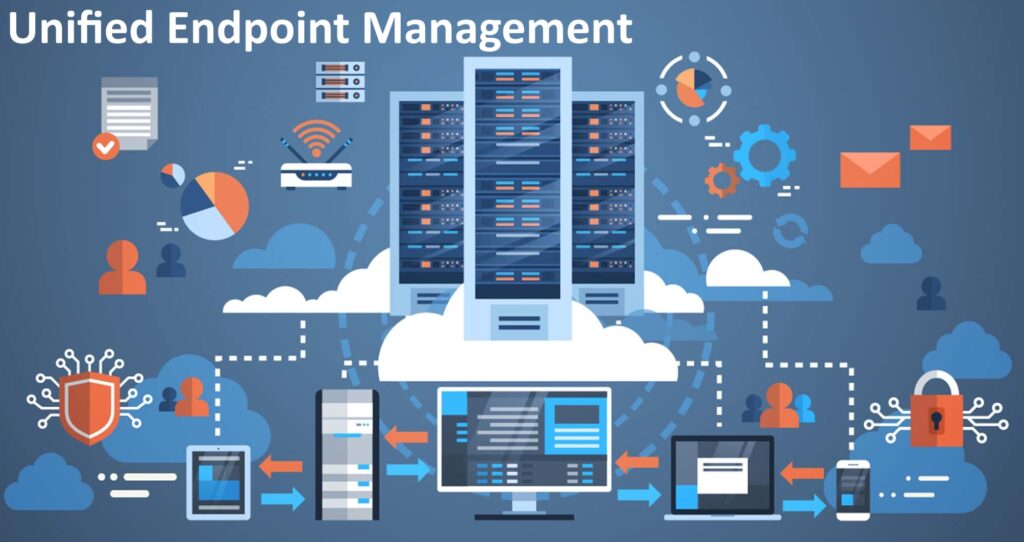
Status: Final Blueprint
Author: Shahab Al Yamin Chawdhury
Organization: Principal Architect & Consultant Group
Research Date: December 7, 2024
Location: Dhaka, Bangladesh
Version: 1.0
Page 1: Strategic Overview & Governance
1. The Strategic Imperative of Unified Endpoint Management (UEM)
The management of endpoint devices has evolved from a tactical IT function into a strategic imperative. This evolution reflects the changing nature of work, from simple Mobile Device Management (MDM) to comprehensive Enterprise Mobility Management (EMM), and now to a unified approach.
- Evolutionary Path: The journey has progressed from MDM (device-level control) -> EMM (adding app, content, and identity management for BYOD) -> UEM (a single platform for all endpoints like PCs, mobile, and IoT). The future is Autonomous Endpoint Management (AEM), which infuses UEM with AI and machine learning for self-healing and self-securing capabilities.
- Core Pillars of UEM: A successful strategy balances three key pillars:
- Security: Foundational to a Zero Trust architecture, enabling identity-driven conditional access and enforcing compliance on the endpoint itself.
- User Experience (DEX): Delivering a seamless digital experience through zero-touch deployment, self-service portals, and proactive performance monitoring.
- Operational Efficiency: Consolidating tools and automating routine tasks like patching and software deployment to reduce costs and free up IT resources.
- UEM Maturity Model: A framework to assess an organization’s capability.
- Level 1: Reactive: Ad-hoc management with no centralized control.
- Level 2: Managed: A single UEM tool is implemented with consistent policies for corporate devices.
- Level 3: Proactive: Management is unified across all platforms; key processes are automated.
- Level 4: Optimized: DEX monitoring is used to improve user experience; UEM is integrated with ITSM/SIEM.
- Level 5: Autonomous: AI-driven automation enables self-healing endpoints, with IT focusing on strategic governance.
2. Governance and Responsibility Framework
Technology is only effective when supported by a robust governance structure that defines policies, processes, and roles.
- Governance Principles:
- Policy: A formal Mobile Device Management Policy defining security requirements (encryption, passcodes, remote wipe) and acceptable use.
- Process: Integration with enterprise systems like HR (for onboarding/offboarding), ITSM (for incident response), and SecOps (for threat remediation).
- People: Ensuring user literacy through training on policies and security responsibilities.
- Key Program Roles:
- UEM Program Manager: Strategic owner of the program.
- UEM Architect: Lead technical authority for design and integration.
- UEM Administrator: Handles day-to-day operations.
- Security Analyst: Monitors endpoint security and investigates threats.
- IT Support/Help Desk: Provides first-line support for end-users.
- RACI Matrix: A Responsibility Assignment Matrix (RACI) is crucial to clarify who is Responsible, Accountable, Consulted, and Informed for every key activity, eliminating ambiguity in cross-functional tasks like incident response.
3. Risk, Control, and Compliance
UEM is a primary tool for mitigating risk and enforcing compliance across the enterprise’s largest attack surface—its endpoints.
- Threat Landscape: UEM helps manage common threats like malware, phishing, and data breaches by providing device inventory, risk-based vulnerability assessment, and automated remediation (e.g., patching, configuration enforcement).
- Controls & Best Practices: UEM operationalizes security frameworks like the Center for Internet Security (CIS) Benchmarks to harden devices. It enables a defense-in-depth strategy by layering controls at the device, application, identity, data, and network levels.
- Regulatory Compliance: UEM is critical for enforcing and auditing compliance with regulations like HIPAA, GDPR, and PCI DSS. It provides the technical controls to meet requirements for access control, encryption, and data protection.
Page 2: Vendor Comparison & Strategic Recommendations
4. Comparative Analysis of Leading UEM Platforms
The UEM market features several leaders, each with a distinct philosophy and set of strengths.
| Vendor | Core Strength / Philosophy | Best For (Use Case) | OS Support (General) | Key Differentiator |
| Microsoft Intune | Unified Management & Security | Microsoft-centric enterprises | Windows, macOS, iOS, Android, Linux | Deep native integration with Microsoft 365, Entra ID, and Defender. |
| VMware Workspace ONE | Digital Employee Experience (DEX) | Diverse environments, VDI, frontline workers | Windows, macOS, iOS, Android, ChromeOS | Market-leading DEX analytics and powerful workflow automation. |
| Ivanti Neurons for UEM | Hyperautomation & Convergence | Breaking down IT/Security silos | Windows, macOS, iOS, Android, Linux, IoT | Native integration of UEM, ESM, and Security in one platform. |
| ManageEngine Endpoint Central | Comprehensive Value Proposition | Cost-conscious organizations needing broad features | Windows, macOS, iOS, Android, Linux, ChromeOS | Exceptionally broad feature set at a highly competitive price point. |
| Jamf Pro | Apple Ecosystem Specialization | Apple-only or Apple-dominant environments | macOS, iOS, iPadOS, tvOS | Unparalleled depth of management and same-day support for new Apple OS releases. |
5. Strategic Blueprint and Recommendations
The final selection should be guided by a strategic framework that aligns with business priorities.
- Key Performance Indicators (KPIs) for Success: A successful UEM program must be measured by a balanced set of KPIs.
- Security: Endpoint Risk Posture, Mean Time to Patch (MTTP), Device Compliance Rate.
- Operational: IT Support Tickets per 100 Endpoints, Automation Rate.
- Financial: Total Cost of Ownership (TCO) per Endpoint.
- User Experience (DEX): User Satisfaction Score, Average Device Boot Time, Application Crash Rate.
- Scenario-Based Recommendations:
- Microsoft Intune: The presumptive choice for organizations heavily invested in the Microsoft ecosystem, prioritizing seamless integration and security.
- VMware Workspace ONE (Omnissa): A compelling choice for organizations prioritizing a best-in-class DEX, especially with diverse endpoints or VDI.
- Ivanti Neurons for UEM: Offers a unique, unified platform for organizations seeking to merge IT and Security operations through hyperautomation.
- Jamf Pro: The undisputed leader for Apple-centric environments where depth of management and day-zero support are critical.
- ManageEngine Endpoint Central: Provides exceptional value for cost-conscious organizations that require a comprehensive, all-in-one feature set.